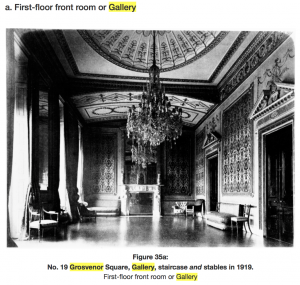The Grosvenor Gallery
The Grosvenor Gallery is mentioned only once in The Picture of Dorian Gray by Oscar Wilde. However, the history on the building is plentiful. It is referred to in the first chapter of the book by Lord Henry. Lord Henry enters the studio where Basil is admiring his greatest work on an easel and says,
“It is your best work, Basil, the best thing you have ever done,” said Lord Henry languidly. “You must certainly send it next year to the Grosvenor. The Academy is too large and too vulgar. Whenever I have gone there, there have been either so many people that I have not been able to see the pictures, which was dreadful, or so many pictures that I have not been able to see the people, which was worse. The Grosvenor is really the only place.”
 (Plate 35: No. 19 Grosvenor Square, Gallery, staircase and stables in 1919).
(Plate 35: No. 19 Grosvenor Square, Gallery, staircase and stables in 1919).
Lord Henry is referring to The Royal Academy of Arts or Burlington House in Piccadilly, London when he says “The Academy.” According to Lord Henry, The Grosvenor Gallery is better suited to display the painting of Dorian by Basil. This is very important to the theme of the book of how art is displayed. Dorian believes artwork, including people, should be appropriately displayed. He believes Sibyl Vane is a work of art in human form and should be displayed as his wife (until he discovers she can no longer act). He also believes Shakespearian works should not be shown in an unworthy theater, such as The Royal Theater, where Sibyl performs.
“I must admit that I was rather annoyed at the idea of seeing Shakespeare done in such a wretched hole of a place” (Chapter 5).
Lord Henry believes that Basil’s painting of Dorian should be displayed in the Grosvenor Gallery where people who will truly appreciate it would see it.
The Grosvenor Gallery was founded by Sir Coutts Lindsay and his wife, Lady Blanche Lindsay as an alternative venue to view art to The Royal Academy. The gallery displayed the work of progressive artists who’s work was ignored due to its lack of adherence to traditional tastes. “The Lindsays’ innovative approach to art, audiences, and exhibition display made the gallery an influential force not only in Victorian art and society but also in the evolution of modern-day museum practice” (Yale University Press).
Previously occupied by Lord Grosvenor until June of 1808, The Grosvenor House was “thrown open to the ‘Fashionable world’” (Old Grosvenor House). The gallery was home to an eclectic collection of art described by The Morning Post as such;
“‘truly magnificent’ chandeliers and Grecian lamps, the vast and beautiful mirrors, the grand staircase, ‘superbly illuminated’ and ‘adorned with the most rare specimens in the art of sculpture’, and the richly gilded ornamental ceilings and cornices…Not everybody was enthusiastic however: Lord Lonsdale, who visited the house in the company of the architect Robert Smirke, found it ‘most expensively furnished, but in a bad taste'”(Old Grosvenor House).
The gallery provided a space for a collection of atypical works of art. It showcased aesthetic art otherwise dismissed by 19th century British standards. It began as a display room for a collection of beautiful things. Similar to Dorian’s aim in life, the gallery was a home for all things pleasing.
Works cited
‘Old Grosvenor House.’ Survey of London: Volume 40, the Grosvenor Estate in Mayfair, Part 2 (The Buildings). Ed. F H W Sheppard. London: London County Council, 1980. 239-250. British History Online. Web. 15 December 2015.
‘Plate 35: No. 19 Grosvenor Square, Gallery, staircase and stables in 1919.’ Survey of London: Volume 40, the Grosvenor Estate in Mayfair, Part 2 (The Buildings). Ed. F H W Sheppard. London: London County Council, 1980. British History Online. Web. 17 December 2015.
“The Grosvenor Gallery: A Palace of Art in Victorian London.” New Haven: Yale University Press, 1996. Print.
Wilde, Oscar. “The Picture of Dorian Gray (1891)/Chapter 1.” Wikisource, the Free Online Library. N.p., n.d. Web.10 Dec. 2015.
